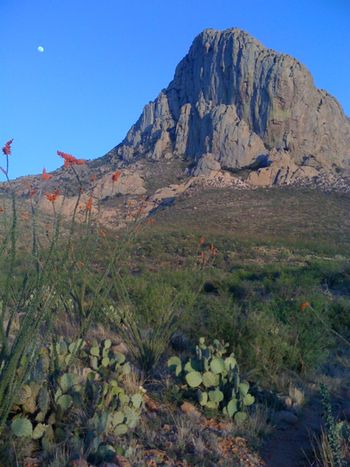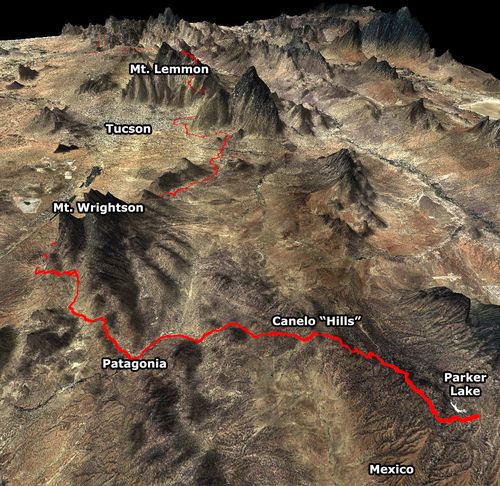
Tomorrow, I set out to settle a two-year-old score.
At 9 a.m. on Friday, I begin my third attempt at the , a self-supported endurance mountain biking race in southern Arizona. The small-scale, unsanctioned event crawls through rugged, rocky, cactus-spiked Sonoran desert, often in blistering heat, though in some years there's also been .
There are two versions of the race. The 300-mile course begins at the Arizona Trail trailhead at Parker Canyon Lake, and after jigging and jogging to Tucson and climbing over Mt. Lemmon it traverses isolated singletrack to finish in Superior, Arizona, just east of Phoenix. The full 750-miler (the Arizona Trail Race, or AZTR) begins at the Mexico border, follows the same course as the 300, and continues along the Arizona Trail beyond Superior to the Utah border, with one slight hiccup: the Grand Canyon. Because bike wheels can't touch dirt in the park, riders must��break down their bikes and hump them rim to rim on their backs.
The AZTR is unique among ultra events in the volume of singletrack it packs. Whereas other races, such as the and the , rely on long stretches of dirt roads, the AZTR is predominantly on the singletrack of the .��It is a grassroots, self-supported ride with no official start list or fees and few (but stringent) rules upheld by the honor system. In short, racers must travel the entire course under their own power, carrying anything they need to support themselves except for items they can buy along the route. Most importantly, riders are on their own—there is no safety net.
Navigation, scant water, and weather (2011 temps sizzled to 100) make the AZTR something not to be undertaken lightly.��Since its debut in 2006, when the race consisted of founder and five friends, only 34 riders have completed the 300 and four have finished the full AZTR. Of the 22 racers who started in 2011, only three reached Superior and one did the entire route. Salsa Cycles' set both course records in 2010: 2 days, 8 hours, and 45 minutes for the 300 en route to 7 days, 6 hours, and 35 minutes for the full meal deal.

A bird's-eye view of the AZT300. �� ��Photo: Courtesy of .
When I first tried the race in 2010, a trip to South Korea kept me from the mass start. I headed out alone a day later to attempt it as an individual time trial but was felled at the end of day one by a stomach bug I brought back from Asia. Last year I was having a much better time when my GPS failed around mile 100. On this circuitious, unmarked, backcountry course, that spelled the end of my race.
And though I've had some bad luck, in hindsight the real culprit for my failures is probably taking the AZTR too lightly.��I've had success at 24-hour and shorter races, and I brought the same mindset to the AZTR: Train hard, I thought, and everything else will fall in place. But I've since learned that in a race like this logistics and planning are at least as imporant as fitness. The AZT300 startline in 2010 was the first time I'd ever ridden with packs on my bike, and I had no sense of the course beyond the thin red track line on my GPS. It probably would have been a miracle if I'd made it to Superior, much less at the fast pace I'd set. What hubris.
My goal this year is first and foremost to finish—if I can do it quickly, all the better.��I'm as prepared as I can be. Thanks to , MTB coach and winner of the 2011 AZT300, I've trained more systematically than ever. I've studied the course (and pre-ridden most of it), tried lots of gear to find what works, have drawn up time splits, calorie counts, and a race plan, and—most importantly—am prepared for the unexpected.
That's the biggest lesson I've learned about self-supported, distance racing: sidewalls shred, trees blow down, the course gets obscure and sometimes even lost, stores close when they're meant to be open. Shit happens, and success rides on your ability to adapt. That's not my strongest suit, but I've prepared myself for it this time. Come stomach bug or failed GPS or whatever eventualities I haven't considered, I plan on riding into Superior.��And I plan on enjoying one hell of a ride getting there. That's the other thing I've learned: racing is a fantastic challenge, but it's pointless how fast you go if you're not having fun.
In addition to mapping the course with the he's developed, organizing the proceedings, and winning more than a few enduro races along the way, Scott Morris also provides . Follow along as racers crawl through the desert.
See you in Superior.
–Aaron Gulley
��